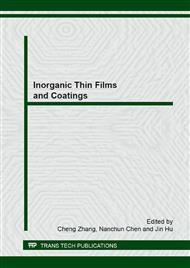[1]
J. Humphreys, M. Hatherly, Recrystallization and Related Annealing Phenomena (Second Edition), in: Recrystallization and Related Annealing Phenomena (Second Edition), Elsevier, New York, 2004, pp.169-214.
DOI: 10.1016/b978-008044164-1/50003-7
Google Scholar
[2]
H.P. Stüwe, A.F. Padilha, F. Siciliano, Competition between recovery and recrystallization, Mater. Sci. Eng. A. 333 (2002) 361-367.
DOI: 10.1016/s0921-5093(01)01860-3
Google Scholar
[3]
X.Y. Song, M. Rettenmayr, Modelling study on recrystallization, recovery and their temperature dependence in inhomogeneously deformed materials, Mater. Sci. Eng. A. 332 (2002) 153-160.
DOI: 10.1016/s0921-5093(01)01720-8
Google Scholar
[4]
S. Zaefferer, T. Baudin, R. Penelle, A study on the formation mechanisms of the cube recrystallization texture in cold rolled Fe-36% Ni alloys, Acta Materialia. 49 (2001) 1105-1122.
DOI: 10.1016/s1359-6454(00)00387-6
Google Scholar
[5]
E. Nes, Recovery revisited, Acta Metall. Mater. 43 (1995) 2189-2207.
Google Scholar
[6]
A. Martínez-de-Guerenu, K. Gurruchaga, F. Arizti, Nondestructive characterization of recovery and recrystallization in cold rolled low carbon steel by magnetic hysteresis loops, J. Magn. Magn. Mater. 316 (2007) 842-845.
DOI: 10.1016/j.jmmm.2007.03.110
Google Scholar
[7]
A. Samet-Meziou, A.L. Etter, T. Baudin, R. Penelle, TEM study of recovery and recrystallizat- ion mechanisms after 40% cold rolling in an IF-Ti steel, Scripta Mater. 53 (2005) 1001-1006.
DOI: 10.1016/j.scriptamat.2005.06.025
Google Scholar
[8]
E.J. Giordani, A.M. Jorge Jr, O. Balancin, Proportion of recovery and recrystallization during interpass times at high temperatures on a Nb- and N-bearing austenitic stainless steel biomaterial, Scripta Mater. 55 (2006) 743-746.
DOI: 10.1016/j.scriptamat.2006.05.015
Google Scholar
[9]
F.J. Humphreys, A unified theory of recovery, recrystallization and grain growth, based on the stability and growth of cellular microstructures II. The effect of second-phase particles, Acta Mater. 45 (1997) 5031-5039.
DOI: 10.1016/s1359-6454(97)00173-0
Google Scholar
[10]
W.C. Liu, J. Li, H. Yuan, Q.X. Yang, Effect of recovery on the recrystallization texture of an Al-Mg alloy, Scripta Mater. 57 (2007) 833-836.
DOI: 10.1016/j.scriptamat.2007.07.008
Google Scholar


